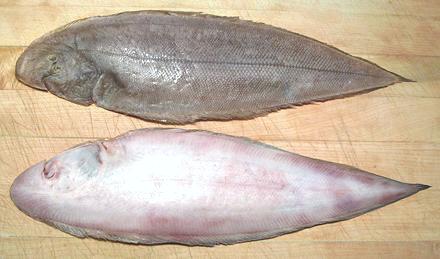 [Cynoglossus bilineatus (Fourlined tonguesole);
Cynoglossus arel (Largescale tonguefish); and Others]
[Cynoglossus bilineatus (Fourlined tonguesole);
Cynoglossus arel (Largescale tonguefish); and Others]
These Indo-Pacific fish are not actually sole, but Tonguefish (family Cynoglossidae). There is a very similar looking fish from the same Indo-Pacific region, (Synaptura commersonnii), also sometimes called "tongue sole" that is actually a sole (family Soleidae). That one can be recognized by having an actual tail (though tiny) and eyes very close to the front.
Tonguesole can grow to around 16 inches are more commonly around 12 inches.The photo specimens were very like C. bilineatus, but I'm not completely confident that's what it is. The upper specimen was 14-1/2 inches long, 4-1/2 inches wide, 7/8 inch thick and weighed 10 ounces.
More on Varieties of Fish (very
large page).
The flesh of this fish is white and light in flavor, but still satisfying. It is very delicate so needs to be handled carefully. The main problems with this fish are its small size, and as with all other fish of this flat form, the fin rays along the edges just about all the way around.
Cooking: The flesh of this fish is quite delicate, but with a light dusting of rice flour fillets can be pan fried successfully. Poached, fillets will curl a bit in a spiral manner. 5 minutes poaching is more than enough. Fillets can be used in recipes that do not disturb them, such as in casseroles, but not in soups where they will pretty much disintegrate. This fish should only be cooked as fillets, because dealing with the fin rays on the plate is not a delight.
Buying: This fish shows up now and then in the Asian fish markets here in Los Angeles. It's not a fish you can just go out and buy, you deal with it when you see it.
Scales: Scales vary in size by species, but scrape off fairly easily with moderate flying about. You will have to shave some of them off with the sharp edge of your knife, particularly around the edges.
Skin: The skin is thin, but has poor adhesion. You can cut through it around the edges just where the fin rays meet the body, and then simply peel it off. Start at the front with just a little scraping to get it going, then pull it back. The skin has a fair amount of shrink when heated, but due to poor adhesion it can be left on for frying fillets. In a poaching bath it will curl the fillet, but not too badly. I do recommend removing the skin for poaching because its flavor and texture, though not unpleasant, will interfere some with the delicate taste of the flesh. Skin off, the fillets will still curl during poaching, but in a spiral.
Cleaning: The best way to handle this fish is to remove the head. This allows very easy removal of the innards which is difficult otherwise. To use the heads for stock you need to remove the gills, best done with a sturdy pair of long nose pliers.
Filleting: As with other fish of this form, the only practical way to fillet it is to make a cut down to the backbone along the centerline. Then fillet by shaving the flesh from the bones working from the backbone out to the edge, making sure the fin rays stay with the skeleton. If any come loose scrape them from the edge of the fillet. How neat the fillets are depends on your patience and the individual fish.
Yield: A 10 ounce fish yielded 5-3/4 ounces of skin-on fillet (58%) which were 4-3/4 ounces skin removed (48%). This is good yield, but the fillets will be small.
Stock: Heads, bones, and fins made a quite usable stock simmered for 1/2 hour. There is almost no oil.
sf_tonguez 110116 - www.clovegarden.com